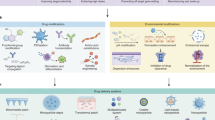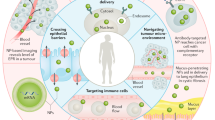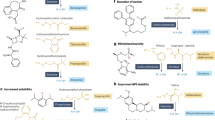Abstract
The Center for Drug Evaluation and Research (CDER) within the US Food and Drug Administration (FDA) is tracking the use of nanotechnology in drug products by building and interrogating a technical profile of products containing nanomaterials submitted to CDER. In this Analysis, data from more than 350 products show an increase in the submissions of drug products containing nanomaterials over the last two decades. Of these, 65% are investigational new drugs, 17% are new drug applications and 18% are abbreviated new drug applications, with the largest class of products being liposomal formulations intended for cancer treatments. Approximately 80% of products have average particle sizes of 300 nm or lower. This analysis identifies several trends in the development of drug products containing nanomaterials, including the relative rate of approvals of these products, and provides a comprehensive overview on the landscape of nanotechnology application in medicine.
This is a preview of subscription content, access via your institution
Access options
Access Nature and 54 other Nature Portfolio journals
Get Nature+, our best-value online-access subscription
$29.99 / 30 days
cancel any time
Subscribe to this journal
Receive 12 print issues and online access
$259.00 per year
only $21.58 per issue
Buy this article
- Purchase on Springer Link
- Instant access to full article PDF
Prices may be subject to local taxes which are calculated during checkout





Similar content being viewed by others
References
Devalapally, H., Chakilam, A. & Amiji, M. M. Role of nanotechnology in pharmaceutical product development. J. Pharm. Sci. 96, 2547–2565 (2007).
Duncan, R. & Gaspar, R. Nanomedicine(s) under the microscope. Mol. Pharmacol. 8, 2101–2141 (2011).
Rizzo, L. Y., Theek, B., Storm, G., Kiessling, F. & Lammers, T. Recent progress in nanomedicine: therapeutic, diagnostic and theranostic applications. Curr. Opin. Biotechnol. 24, 1159–1166 (2013).
Thorley, A. J. & Tetley, T. D. New perspectives in nanomedicine. Pharmacol. Ther. 140, 176–185 (2013).
US FDA. Considering Whether an FDA-Regulated Product Involves the Application of Nanotechnology http://www.fda.gov/RegulatoryInformation/Guidances/ucm257698.htm (2014).
Hamburg, M. A. FDA's approach to regulation of products of nanotechnology. Science 336, 299–300 (2012).
Lostritto, R. T., Goei, L. & Silvestri, S. L. Theoretical considerations of drug release from submicron oil in water emulsions. J. Parenter. Sci. Technol. 41, 214–219 (1987).
U.S. FDA. Guidance, Compliance, & Regulatory Information http://www.fda.gov/Drugs/GuidanceComplianceRegulatoryInformation/ (2015).
Tyner, K. M. et al. Product quality for nanomaterials: current U.S. experience and perspective. Wiley Interdiscip. Rev. Nanomed. Nanobiotechnol. 7, 640–654 (2015).
Brown, P. D. & Patel, P. R. Nanomedicine: a pharma perspective. Wiley Interdiscip. Rev. Nanomed. Nanobiotechnol. 7, 125–130 (2015).
Poste, G. et al. Analysis of the fate of systemically administered liposomes and implications for their use in drug delivery. Can. Res. 42, 1412–1422 (1982).
Weissig, V., Pettinger, T. K. & Murdock, N. Nanopharmaceuticals (part 1): products on the market. Int. J. Nanomed. 9, 4357–4373 (2014).
Letter, T. M. Griseofulvin: a new formulation and some old concerns. Med. Lett. Drugs Ther. 18, 17–18 (1973).
Wu, Y. et al. Core size determination and structural characterization of intravenous iron complexes by cryogenic transmission electron microscopy. Int. J. Pharm. 505, 167–174 (2016).
Jahn, M. R., Mrestani, Y., Langguth, P. & Neubert, R. H. CE characterization of potential toxic labile iron in colloidal parenteral iron formulations using off-capillary and on-capillary complexation with EDTA. Electrophoresis 28, 2424–2429 (2007).
US FDA. CDER New Drug Review: 2014 Update http://www.fda.gov/AboutFDA/CentersOffices/OfficeofMedicalProductsandTobacco/CDER/ucm074833.htm (2014).
Dickson, M. & Gagnon, J. P. The cost of new drug discovery and development. Discov. Med. 4, 172–179 (2004).
Hay, M., Thomas, D. W., Craighead, J. L., Economides, C. & Rosenthal, J. Clinical development success rates for investigational drugs. Nat. Biotechnol. 32, 40–51 (2014).
Committee for the Review of the National Nanotechnology Inititative. Preliminary Comments, Review of the National Nanotechnology Initiative (National Academies Press, 2001); https://www.nap.edu/read/10216/chapter/1
DiMasi, J. A., Hansen, R. W. & Grabowski, H. G. The price of innovation: new estimates of drug development costs. J. Health. Econ. 22, 151–185 (2003).
Evens, R. P. in Drug and Biological Development: From Molecule to Product and Beyond (ed. Evens, R. P.) Ch. 1, 5–32 (Springer, 2007).
US Congress, Office of Technology Assessment. Government Regulation and Pharmaceutical R&D. 135–168 (US Government Printing Office, 1993).
Helmus, M. N. The need for rules and regulations. Nat. Nanotech. 2, 333–334 (2007).
US Food and Drug Administration. Bioequivalence Recommendations for Specific Productshttp://www.fda.gov/downloads/Drugs/GuidanceComplianceRegulatoryInformation/Guidances/UCM072872.pdf (2010)
Allen, T. M. & Cullis, P. R. Liposomal drug delivery systems: from concept to clinical applications. Adv. Drug Deliv. Rev. 65, 36–48 (2013).
Jesorka, A. & Orwar, O. Liposomes: technologies and analytical applications. Annu. Rev. Anal. Chem. 1, 801–832 (2008).
Barenholz, Y. Doxil®—The first FDA-approved nano-drug: lessons learned. J. Control Rel. 160, 117–134 (2012).
Jiang, W., Lionberger, R. & Yu, L. X. In vitro and in vivo characterizations of PEGylated liposomal doxorubicin. Bioanalysis 3, 333–344 (2011).
Sercombe, L. et al. Advances and challenges of liposome assisted drug delivery. Front. Pharmacol. 6, 286 (2015).
Blanco, E. et al. Nanomedicine in cancer therapy: innovative trends and prospects. Cancer Sci. 102, 1247–1252 (2011).
Sumer, B. & Gao, J. Theranostic nanomedicine for cancer. Nanomedicine 3, 137–140 (2008).
Davis, M. E., Chen, Z. G. & Shin, D. M. Nanoparticle therapeutics: an emerging treatment modality for cancer. Nat. Rev. Drug Discov. 7, 771–782 (2008).
Jain, R. K. & Stylianopoulos, T. Delivering nanomedicine to solid tumors. Nat. Rev. Clin. Oncol. 7, 653–664 (2010).
Lammers, T., Hennink, W. E. & Storm, G. Tumour-targeted nanomedicines: principles and practice. Br. J. Cancer 99, 392–397 (2008).
Bartlett, J. A. et al. Summary report of PQRI workshop on nanomaterial in drug products: current experience and management of potential risks. AAPS J. 17, 44–64 (2015).
Hall, J. B., Dobrovolskaia, M. A., Patri, A. K. & McNeil, S. E. Characterization of nanoparticles for therapeutics. Nanomedicine 2, 789–803 (2007).
Tyner, K. & Sadrieh, N. Considerations when submitting nanotherapeutics to FDA/CDER for regulatory review. Methods Mol. Biol. 697, 17–31 (2011).
Kobayashi, H. & Brechbiel, M. W. Dendrimer-based macromolecular MRI contrast agents: characteristics and application. Mol. Imaging 2, 1–10 (2003).
De Jong, W. H. et al. Particle size-dependent organ distribution of gold nanoparticles after intravenous administration. Biomaterials 29, 1912–1919 (2008).
Alexis, F., Pridgen, E., Molnar, L. K. & Farokhzad, O. C. Factors affecting the clearance and biodistribution of polymeric nanoparticles. Mol. Pharm. 5, 505–515 (2008).
Gmoshinski, I. V. et al. Nanomaterials and nanotechnologies: methods of analysis and control. Russ. Chem. Rev. 82, 48 (2013).
Linkov, P., Artemyev, M., Efimov, A. E. & Nabiev, I. Comparative advantages and limitations of the basic metrology methods applied to the characterization of nanomaterials. Nanoscale 5, 8781–8798 (2013).
Powers, K. W. et al. Research strategies for safety evaluation of nanomaterials. Part VI. Characterization of nanoscale particles for toxicological evaluation. Toxicol. Sci. 90, 296–303 (2006).
Powers, K. W., Palazuelos, M., Moudgil, B. M. & Roberts, S. M. Characterization of the size, shape, and state of dispersion of nanoparticles for toxicological studies. Nanotoxicology 1, 42–51 (2007).
Warheit, D. B. How meaningful are the results of nanotoxicity studies in the absence of adequate material characterization? Toxicol. Sci. 101, 183–185 (2008).
Bhattacharjee, S. DLS and zeta potential—what they are and what they are not? J. Control Rel. 235, 337–351 (2016).
Anderson, W., Kozak, D., Coleman, V. A., Jamting, A. K. & Trau, M. A comparative study of submicron particle sizing platforms: accuracy, precision and resolution analysis of polydisperse particle size distributions. J. Colloid Interface Sci. 405, 322–330 (2013).
Boverhof, D. R. & David, R. M. Nanomaterial characterization: considerations and needs for hazard assessment and safety evaluation. Anal. Bioanal. Chem. 396, 953–961 (2009).
Lin, P.-C., Lin, S., Wang, P. C. & Sridhar, R. Techniques for physicochemical characterization of nanomaterials. Biotechnol. Adv. 32, 711–726 (2014).
McNeil, S. E. (ed.) Characterization of Nanoparticles Intended for Drug Delivery Vol. 697 (Springer, 2011).
Sapsford, K. E., Tyner, K. M., Dair, B. J., Deschamps, J. R. & Medintz, I. L. Analyzing nanomaterial bioconjugates: a review of current and emerging purification and characterization techniques. Anal. Chem. 83, 4453–4488 (2011).
Grau, M. J., Kayser, O. & Muller, R. H. Nanosuspensions of poorly soluble drugs—reproducibility of small scale production. Int. J. Pharm. 196, 155–159 (2000).
Muller, R. H., Jacobs, C. & Kayser, O. Nanosuspensions as particulate drug formulations in therapy. Rationale for development and what we can expect for the future. Adv. Drug Deliv. Rev. 47, 3–19 (2001).
European Commission. Recommendation on the Definition of Nanomaterial (European Commission, 2011).
Health Canada. Policy Statement on Health Canada's Working Definition for Nanomaterial (Health Canada, 2011).
ISO. International Organization for Standardization/Technical Specification, Nanotechnologies–Vocabulary–Part 1: Core terms, 2010, ISO/TS 80004-1:2010 (ISO, 2010).
NSTC/CoT/NSET. National Nanotechnology Initiative Strategic Planhttp://www.nano.gov/sites/default/files/pub_resource/2014_nni_strategic_plan.pdf (February 2014).
Bancos, S., Stevens, D. L. & Tyner, K. M. Effect of silica and gold nanoparticles on macrophage proliferation, activation markers, cytokine production, and phagocytosis in vitro. Int. J. Nanomed. 10, 183–206 (2015).
Bancos, S., Tsai, D.-H., Hackley, V., Weaver, J. L. & Tyner, K. M. Evaluation of viability and proliferation profiles on macrophages treated with silica nanoparticles in vitro via plate-based, flow cytometry, and Coulter counter assays. ISRN Nanotechnol. 2012, 454072 (2012).
Keene, A. M. et al. Tissue and cellular distribution of gold nanoparticles varies based on aggregation/agglomeration status. Nanomedicine 7, 199–209 (2012).
Keene, A. M. & Tyner, K. M. Analytical characterization of gold nanoparticle primary particles, aggregates, agglomerates, and agglomerated aggregates. J. Nanopart. Res. 13, 3465–3481 (2011).
Acknowledgements
This project was supported in part by an appointment to the Research Participation Program at the Center for Drug Evaluation and Research administered by the Oak Ridge Institute for Science and Education through an interagency agreement between the US Department of Energy and the US Food and Drug Administration. The findings and conclusions in this Analysis have not been formally disseminated by the Food and Drug Administration and should not be construed to represent any Agency determination or policy. The mention of commercial products, their sources, or their use in connection with material reported herein is not to be construed as either an actual or implied endorsement of such products by the Department of Health and Human Services.
Author information
Authors and Affiliations
Contributions
K.M.T., C.N.C. and S.L.L. conceived and designed the project. S.R.D., M.K. and M.-L.C. conducted the analysis. K.M.T. and S.R.D. co-wrote the paper. All authors discussed the results and commented on the manuscript.
Corresponding author
Ethics declarations
Competing interests
The authors declare no competing financial interests.
Supplementary information
Supplementary information
Supplementary information (PDF 314 kb)
Rights and permissions
About this article
Cite this article
D'Mello, S., Cruz, C., Chen, ML. et al. The evolving landscape of drug products containing nanomaterials in the United States. Nature Nanotech 12, 523–529 (2017). https://doi.org/10.1038/nnano.2017.67
Received:
Accepted:
Published:
Issue Date:
DOI: https://doi.org/10.1038/nnano.2017.67
This article is cited by
-
β-1,3-d-glucan lentinan/Poly-dA40 triple-helical complex in dilute solutions
Polymer Journal (2024)
-
Research Landscape of Physiologically Based Pharmacokinetic Model Utilization in Different Fields: A Bibliometric Analysis (1999–2023)
Pharmaceutical Research (2024)
-
Bioimaging guided pharmaceutical evaluations of nanomedicines for clinical translations
Journal of Nanobiotechnology (2022)
-
Nanotechnology-aided advancement in the combating of cancer metastasis
Cancer and Metastasis Reviews (2022)
-
Current hurdles to the translation of nanomedicines from bench to the clinic
Drug Delivery and Translational Research (2022)



